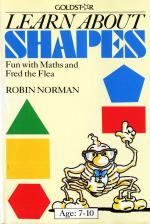Note To Parents
The most valuable things that you can give children are your time and your interest. Take some time off to go through the program and play the game with them, and you will find that the rewards are very great!
It will help to go through the instructions with them, even though they are not difficult and most children pick them up quickly as they work through the program, as this will eliminate any confusion caused by lack of understanding.
Most of the material in the program should be familiar to children by the age of nine, but older children who are having some difficulty with their maths skills, will find the program beneficial. Children of all ages enjoy playing the game. The activities in the booklet can be worked away from the computer and should provide extra hours of learning fun.
Meet Fred
Fred the Flea is Goldstar's helper in its primary and junior school programs. When the title page has loaded, you'll be able to meet Fred, who you can use to answer questions later on. Fred is there to help make learning more fun.
To move Fred around the screen you use the arrow keys on the right of your keyboard. To practise this, type the letter N when you are asked "Have you met Fred the Flea?"
Once you've learned how to move Fred and you want to go on to the next part of the program type the letter Y in answer to "Have you met Fred the Flea?"
When you see the instruction Press the bar, press the Space bar at the centre bottom of your machine.
What You Will Learn
In the first part of the program, Fred will introduce you to the five basic shapes:
- Triangle (three sides)
- Square (four sides all the same)
- Rectangle (four sides with opposite sides equal)
- Pentagon (five sides)
- Hexagon (six sides)
These are all flat shapes which you can draw on a piece of paper. In this program the shapes are simplified because they are all regular shapes. They all have equal angles and sides, apart from the rectangle. Remember that a square is really a special kind of rectangle, because it also has opposite sides equal.
First you will see the shapes drawn with thin lines, but later you will see them filled in with colour. After each shape is identified and shown in a number of different sizes and colours, a random shape will appear on the screen and you will be asked whether or not it is the one indicated.

The correct answer is yellow. You'd have to move Fred downwards and then press RETURN |

The correct answer is green. So Fred will have to be moved down. |

The correct answer is pentagon. Fred's in the right place! |

Use Fred to help you locate the identical shapes. |
Match The Samples With Fred
Once you've been through the first part of the program, Fred will quiz you on what you have learned. You will be shown three shapes at a time and you will use Fred to answer questions about them like the ones shown opposite.
If you answer the question correctly, you will be congratulated! If you get it wrong, you'll hear a different noise and be asked to try again. When you finish your quiz you will see your score.
You can do the quiz as often as you like, the questions will always be slightly different, and then you can go on to the game, or maybe you'd like to try some of the activities in this booklet.
Find The Shapes With Fred
Here you use your five shapes to play a memory game. You can play it on your own, but it is more fun with two or three.
You will see a set of 24 boxes on screen; all of them are closed so that you cannot see what is inside them. Each box has a particular shape of a certain colour in it (yellow square, red triangle, green hexagon, and so on). Each different coloured shape has an identical "partner" in another of the other boxes. You have to find the pairs.
When it is your turn, open a box by moving Fred onto that box and then press RETURN. Then open a second box in the same way. If the two coloured shapes are exactly the same, you score them, and the two boxes will be coloured yellow all over to show that they are now empty. If they are different, you get no score, and you must try to remember where the shapes are so that you find them later on.
You can play this game as often as you like, as the colours and shapes will always be different. We hope that you enjoy this program, and have fun playing it with your family and friends.
Name The Shapes
First connect the dots to find your shapes, then write in the correct name underneath.
Find The Shapes
Identify the shapes you recognise in the picture below by colouring in all triangles in red squares in blue, rectangles in green, pentagons in yellow and hexagons in purple. Look out for these shapes at home, at school and everywhere you go. You will find them in all sorts of places!
Tiling Your Walls
Maybe your teacher has talked about tessellation. This is where you fit together differently shaped tiles on the walls or floor without overlapping, as with the triangles below.
Pretend you are going to tile your wall. Which shapes can you use? Trace the shapes below on cut-out paper and try putting them together.










